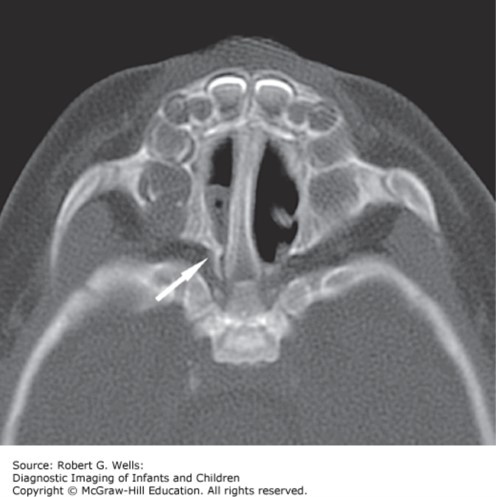The parents report that the infant has had apparent trouble breathing since birth, with frequent clear right-sided nasal discharge. Review of the birth records show that the patient was born at 40 weeks’ gestation by uncomplicated vaginal delivery and had a normal newborn nursery stay. The infant is breastfeeding and the mother feels that she frequently stops feeding to “catch her breath.”

Given this presentation, your clinical suspicion is for:
A. Meningitis.
B. Viral upper respiratory infection.
C. Choanal atresia.
D. Chlamydia trachomatis infection.
E. Heart failure.
The correct answer is “C.” This patient may have choanal atresia (blocked posterior nasal opening), which is the most common congenital anomaly of the nose and occurs in approximately 1 in 7000 live births. It is typically unilateral and is twice as common in females. Remember that neonates are obligate nasal breathers and anything that creates nasal obstruction (such as choanal atresia) may present as respiratory distress. Option “A” is incorrect because the clinical picture does not fit meningitis. Option “B” is incorrect because you would not expect unilateral discharge with a viral URI. Option “D” is incorrect because you would most commonly see conjunctivitis or pneumonia as a result of neonatal C. trachomatis infection. Although you should think of possible heart failure whenever a young child is having difficulty with feedings, the case description is clearly focusing on an upper airway issue; thus option “E” is incorrect.
Sources:
Question & Explanation: Peterson AR, Wood KE. Pediatrics Examination and Board Review. New York, NY: McGraw-Hill Education; 2017.
Photo: Wells RG. Diagnostic Imaging of Infants and Children; 2015.







Create a Free MyAccess Profile
AccessMedicine Network is the place to keep up on new releases for the Access products, get short form didactic content, read up on practice impacting highlights, and watch video featuring authors of your favorite books in medicine. Create a MyAccess profile and follow our contributors to stay informed via email updates.